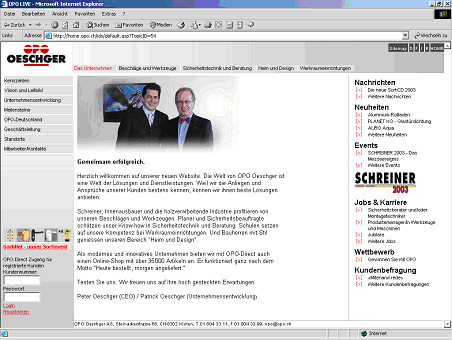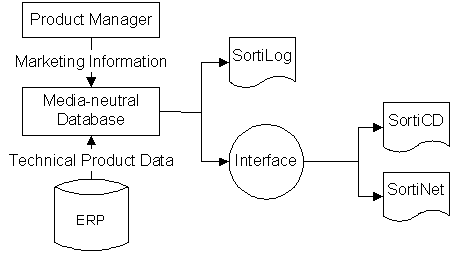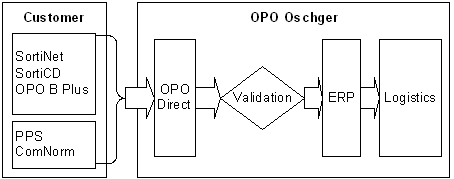Process integration at OPO Oeschger AG
This case study shows how OPO Oeschger has integrated its internal and intercompany order processes. It has eliminated media gaps in publishing its product range and in order processing. With IMIS AG, an enterprise application integration specialist, the company has automated internal and external interfaces based on existing business processes. This has led to considerably lower process costs.
Inhaltsverzeichnis
1. OPO Oeschger AG2. The pioneer
Electronic ordering, E-Business
3. Efficiency and customer relations
Business processes, Process design
4. In-house integration
Media-neutral database
5. Intercompany integration
6. Calculating economic viability
Cost savings through in-house integration, Cost savings through intercompany integration
1. OPO Oeschger AG
OPO Oeschger AG is Switzerland’s leading retailer of fittings, tools and machines for the timber industry. The company’s head office and logistics centre are in Kloten. In financial 2002, OPO Oeschger AG and its 240 employees generated turnover of 104.4 million Swiss francs.[1]
we have been able to cut process costs by 90%.”
(Peter Oeschger, CEO, OPO Oeschger AG)
Oeschger is active in three business areas:
- Fittings, Machines and Tools: OPO Oeschger has supplied fittings for 77 years. 90% of turnover is attributable to this operating area. The target group comprises all wood-processing companies in Switzerland. Its 15,000 customers are cabinet-makers, interior designers, door, window and furniture manufacturers, carpenters and architects. Every day the logistics centre processes up to 1,700 deliveries. In 1998, OPO Oeschger expanded its activities in this area to Germany.
- Security Systems and Consulting: this business area is still in development. OPO Oeschger supports its customers in planning and implementing entry, door and exit systems as part of a comprehensive security concept.
- Home and Design: OPO Oeschger’s Home and Design business line is focused on end customers. Customers receive advice on planning new buildings or conversions in seven information centres.
- Workshop Installations: OPO Oeschger furnishes school workshops with tools, machines and materials.
2. The pioneer
Customers of OPO Oeschger have been able to process their orders electronically since 1988. Back then, modems and telephone lines were used. Peter Oeschger installed the modems for the first customers himself in order to foster confidence. He develops visions for the use of new technologies and motivates customers and staff to use them. He can rightly be considered a pioneer. At OPO Oeschger, “E-Business has top priority”, a motto which defines his role. In the meantime, new channels for electronic ordering have been added. In this respect, the OPO Oeschger model has been copied by much of the industry in Europe.

Fig. 1: Pioneering spirit: father and son: Peter Oeschger and Patrick Oeschger
The operative responsibility for E-Business rests with the Marketing Dept. The department distinguishes between responsibility for data and for publications:
- The product managers are responsible for the product data. They buy products from around 900 suppliers, negotiate pricing and enter the data into the ERP system.
- Publication responsibility is vested in the Marketing Services and Production area. It is responsible for creating publications from the media-neutral database.
Internal IT is responsible for operating the IT infrastructure and maintaining the company’s custom and standard software. It also develops some software itself.
The sales force promotes electronic ordering by motivating customers in their sales areas to place simple orders electronically. This enables the field personnel to devote more of their time to services and orders requiring more assistance and thus boost sales.
A bonus system also motivates the sales force of OPO Oeschger: it is paid out based on total turnover in their area, regardless of the channel used by incoming orders.
As realisation partner, IMIS AG supported Peter Oeschger in realising his business model vision of electronic processing. IMIS AG produced a CD-ROM containing the product range, implemented the web site and automated data processing.
3. Efficiency and customer relations
By providing electronic support for its internal and intercompany business processes, OPO Oeschger aims for more efficient process design and to serve customer retention through high readiness to deliver (98%) and short delivery times.
In-house integration enables OPO Oeschger to keep its product range up to date, to maintain it centrally and to communicate with customers via a variety of publication channels.
OPO Oeschger guarantees next-day delivery of goods if the order is received by 4.30 p.m. The thoroughly integrated processes enable these short delivery times. At the same time, this downstream integration incorporates the customer into OPO Oeschger business processes representing an additional bond to the company.
we can design our processes end-to-end.”
(Peter Oeschger, CEO, OPO Oeschger AG)
4. In-house integration
The OPO Oeschger product range comprises 35,000 articles. The stock list changes continuously. The range is communicated to customers through three publications.
- SortiLog: thanks to its structure, the print catalogue is suitable as a reference work.
- SortiCD: since 1996, OPO Oeschger has been offering its entire range on CD-ROM.
- SortiNet: the entire range of fittings, machines and tools is also presented in the integrated online shop. Customers quickly find the articles they want using various search aids.
In order to minimise costs in processing the data for the various publications, OPO Oeschger employs a media-neutral database (see Fig. 2). This is the heart of the presentation and enables management of articles regardless of their subsequent use.
Some of the article data is loaded from the ERP system into the media-neutral database. The product manager augments the data with marketing information on the products such as images and text.
SortiLog is produced directly from the media-neutral database. It is issued as a new edition every three years.
The article information for publication on the SortiCD and in SortiNet are compiled via an interface. Every year a new CD-ROM is issued containing the current range. The information in SortiNet is updated monthly making it highly current.

Fig. 2: In-house integration
5. Intercompany integration
Customers’ IT equipment varies widely. That’s why OPO Oeschger caters for their current state of technology use. They can order personally from the sales force, by fax, letter or phone, from their own PC or directly via the internet. OPO Oeschger provides customers with five channels for electronic orders: Three of them are proprietary OPO applications; two are based on interfaces to OPO Direct in third-party applications (see Fig. 3).

Fig. 3: Intercompany integration
The customer can select articles directly via the internet (SortiNet), SortiCD or OPO B Plus. Using OPO B Plus, the selection is made directly in OPO Direct. Using SortiNet and SortiCD, the order is saved in a local shopping basket on the customer’s PC. Once the order is confirmed it is transmitted to OPO Oeschger.
Many carpentry software houses have integrated an interface that enables joiners to transmit their parts lists from their planning software to the OPO Oeschger order system. In order to motivate software companies to support this interface, OPO Oeschger organises a fair every three years where they can showcase their products. In the first year, companies were not charged for attendance if they integrated the interface into their software.
In conjunction with professional organisations and a number of innovative suppliers in the joinery industry, the Federation of Swiss Carpentry Software developed a common standard (ComNorm) for data interchange. It means that requests for prices, orders and other article information can be transmitted directly from the customary environment of an industry solution to suppliers via the internet. OPO Direct also supports this interface.
Currently, these measures have led to 22% of customer orders arriving in OPO Direct, entirely without manual intervention by OPO Oeschger.
The responsible regional salesperson checks the order for inconsistencies and contacts the customer if need be. Once the order is confirmed it is routed to the inventory management system that in turn triggers a delivery in the logistics centre.
6. Calculating economic viability
Cost savings resulting from in-house integration:
The central media-neutral database enables data management independent of the subsequent use of the data in the internet, on the CD-ROM or in the catalogue. This has rationalised the updating process for the product managers. It supports all media simultaneously and thus simplifies OPO-internal workflows. The product managers enter their information just once. Publication of this information in the various channels is automatic.
The costs of media production have been massively reduced thanks to the interfaces implemented by IMIS. The catalogue costs OPO Oeschger CHF 1 million. Publishing the product range on CD-ROM and on the internet is more current and costs a fraction. By adding the CD-ROM and the internet to our publication channels, OPO Oeschger produces no more catalogues than it did before, in spite of a larger customer base.
Cost savings resulting from intercompany integration:
The value of orders has remained virtually the same across all channels. Yet Peter Oeschger is convinced that he was only able to master the turnover growth of the last few years without a disproportionate rise in costs thanks to the electronic order option. OPO Oeschger generates 40% of turnover through electronic channels, 22% of which is from customers. The external sales force, too, records and transmits the orders they receive electronically from their notebooks. The remaining 60% of orders are received by fax and phone or are picked up at the office in Kloten.
The main benefit of the integration, however, is the shift of orders to more cost-effective channels. In this way, OPO Oeschger has reduced its process costs for electronic sales orders by 90 per cent. Electronic orders are largely error-free which leads to fewer erroneous deliveries. Orders are no longer entered manually. The integrated solution means that there are no media gaps in the process chain between the order and dispatch. This has a direct impact on the profit marginal.
OPO Oeschger passes on a portion of the cost savings to its customers by granting a 2% discount. Besides this bonus, they also benefit from the system by being able to request prices, availability and terms and monitor their orders around the clock.
SortiNet is also actively used as a source of information on the products. Administration, logistics and sales access the data as they require. The warehouse staff also access order positions and product images electronically. This leads to a reduction in errors.
In the long term, intercompany integration is having a positive effect on the entire company. OPO Oeschger’s image as an innovative partner means it can enhance customer relations and thus raise its strategic position.
![]()
[1] This case study is based on discussions between Peter Oeschger, Sabrina Tammaro and the authors on 3rd July, 2003.





